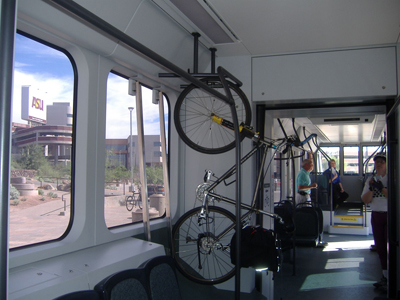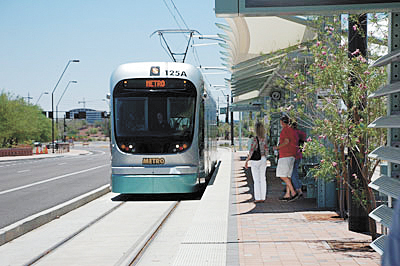When free light rail ends, ASU students still ride free
By Linda Bentley | December 31, 2008
ASU student says, ‘You get what you pay for’
PHOENIX – After receiving an e-mail on Monday saying Arizona State University students can obtain passes to ride Valley Metro transit, including light rail, for free, Craig Cantoni, author and columnist, responded, “That was an April Fool’s joke, right?” He said, “Certainly, a university that teaches social justice wouldn’t endorse such an unjust policy.”
 It turns out it is indeed true. The highly subsidized light rail will join buses in being 100 percent subsidized for ASU students, while ASU employees will receive a 56 percent discount, which, like parking permits, may be paid pre-tax via payroll deduction.
It turns out it is indeed true. The highly subsidized light rail will join buses in being 100 percent subsidized for ASU students, while ASU employees will receive a 56 percent discount, which, like parking permits, may be paid pre-tax via payroll deduction.
The regular fare is currently $1.25 for one ride, $2.50 for a one-day pass, $7.50 for a three-day pass, $17.50 for a seven-day pass and $45 for a monthly pass.
The actual cost to provide a single boarding is closer to $12.
The free student passes are paid for by ASU, whose regents gave ASU President Michael Crow a 25 percent raise last year to $720,000, not counting bonuses, and are raising tuition for 2009.
ASU ordered 30,000 annual transit passes from the city of Phoenix for $700,000, which is just over $23 apiece. The cost would otherwise be $540.
Phoenix will bill an additional $0.798 per boarding, providing students properly register their pass each time they ride, with a not-to-exceed limit of $1 million for the student boarding pass program.
The program was initiated in response to a shortage of parking and parking fee increases at ASU.
Valley Metro held its grand opening light rail this past weekend treating revelers with a free ride from one end of the line to the other, which, on Saturday, reportedly took one hour and 25 minutes.
Valley Metro’s website claims the trip for the “entire 20-miles” is 60 minutes.
There are a number of blogs where people have posted ratings and comments about all of the Valley’s public transportation.
Nick K. provided his observations about Tempe’s Orbit Bus System, giving it one star out of five only because there was no means to give it a zero. He then gave it another star because it’s free, adding, “You get what you pay for.”
If Nick had his way, “where only sane people with good personal hygiene were allowed to board,” he said he’d give it five stars.
Sara B., who gave Phoenix’s Valley Metro two stars, stated, “The last time I rode the bus someone must have shit their pants,” and said it was extremely inconvenient to walk the extra distance to class.
She said, “I haven’t been on one since,” but noted it was free and “the only thing that made it worth riding.”
Norma R. stated, “I used to ride the bus every day in high school. I enjoy the theory, but the smell of it (you guessed it … urine) bugs me to no end.”
Erin gave it two stars, stating she would have given her experience four stars if Valley Metro’s website hadn’t instructed her to take the 122 to the 15 to the 19 to get downtown when all she needed to do was take the Red Line the entire way.
Giving it three stars, Diana F. commented, “You definitely need to set aside a good chunk of time to get where you’re going!”
Matt S. wrote, “The Blue Line was great because I could pick it up just outside my home … and take it through the Camelback corridor, down Central to downtown, without a transfer.”
 Because light rail does away with the redundant portion of the Blue Line, it’s new southern terminus is Central and Camelback, which Matt called “a fortuitous landing for Applebees’ aficionados,” but said, “As for me, I will need to leave the Blue Line and wait for another form of transport, presumably light rail … to go downtown. On second thought, maybe I’ll just hop in the car.”
Because light rail does away with the redundant portion of the Blue Line, it’s new southern terminus is Central and Camelback, which Matt called “a fortuitous landing for Applebees’ aficionados,” but said, “As for me, I will need to leave the Blue Line and wait for another form of transport, presumably light rail … to go downtown. On second thought, maybe I’ll just hop in the car.”
In a September editorial for College Media Network, ASU student Mutinkhe Kaunda stated LifeRailAZ.com reported businesses, real estate developers, restaurants and hotels were all vying for spots along the rail line, “perhaps envisioning the hordes of commuters, including rambunctious ASU students that will inundate them with business once the light rail opens.”
Kaunda said stricter penalties for DUIs, high gas prices and photo radar might get students to leave their cars at home. However, she casted doubts that light rail would lower the number of DUIs.
Pointing to the inconvenience of its fixed route, she said unless one lived close by, light rail still necessitated commuters to use park and ride lots, take a bus or walk to use.
Contrary to most news reports, light rail didn’t debut with all glowing reviews.
Dave O., who road it over the weekend, gave it one star and said, “What a bunch of crap … Who cares how quiet and clean it is on its first weekend when it’s clearly not going to stay this way? Let’s see how popular it is in the summertime.”
He said it is slower than a car going the same route, and asked, “Does this not defeat the purpose of a train in the first place? We’re all going to see how safe it is … I give this until the end of March for hitting a pedestrian.”
Another rider, who caught the light rail after waiting an hour for the connecting shuttle from the airport, reported, shortly after boarding the light rail, being abruptly ordered off somewhere along Washington Street when it apparently ceased running for the day, leaving him stranded late at night with two suitcases in the middle of downtown.
In January 2007, a Phoenix City Council Report regarding the Regional Public Transit Authority Fare Policy Study, discussed reducing fares from $1.25 to $1, claiming the reduced fare “will result in increased boardings and revenue.”
However, on Monday, Valley Metro announced a series of Regional Transit Fare Policy Public Hearings beginning on Tuesday, Jan. 6 throughout the Valley to discuss proposed fare increases due to a decline in sales tax revenues, which funds the bulk of the Valley’s transit services. A fare increase of up to $1 for the $1.25 one-ride fare is being proposed, with additional price increases for all-day, three-day, seven-day and 31-day passes.
A free public Webinar is available on Thursday, Jan. 8 from 10 to 11 a.m. to the first 1,000 people who sign up at www1.gotomeeting.com/register/232190832.
Public comments about fares may also be e-mailed to fares@ ValleyMetro.org through Jan. 23.
Photos: Valley Metro made its debut over the weekend with a grand opening celebration and free ride from one end of the 20 mile line to the other, which reportedly took one hour and 25 minutes. Free rides were available through the end of December.
Courtesy photos
